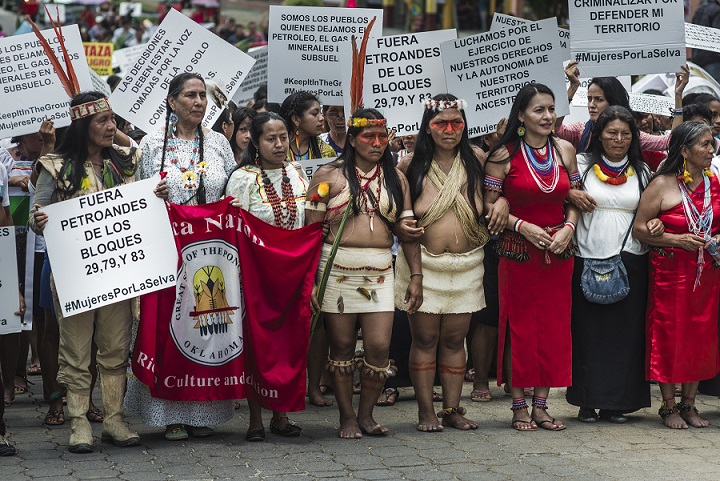
by Deep Green Resistance News Service | Mar 9, 2016 | Indigenous Autonomy, Protests & Symbolic Acts
By WECAN International
SAN FRANCISCO, Calif., March 9, 2016 – In recognition of International Women’s Day, Indigenous Amazonian women leaders of seven nationalities including: Andoa, Achuar, Kichwa, Shuar, Shiwiar, Sapara and Waorani nationalities and their international allies took action in Puyo, Ecuador, in a forum and march in defense of the Amazon, Mother Earth and for climate justice. Specifically, they came together to denounce a newly signed oil contract between the Ecuadorian government and Chinese oil corporation Andes Petroleum.
By plane, foot, canoe, and bus, some five hundred women mobilized from deep in their rainforest territories and nearby provinces marching through the streets of the Amazon jungle town of Puyo.
Chanting, “Defend the forest, don’t sell it!” and carrying signs reading “No more persecution against women defenders of Mother Earth,” the march culminated in a rally in which each nationality denounced the new oil threat and shared traditional songs and ceremonies. The women spoke of other methods for protecting and defending the Amazon and its vital living systems, making it known that the women of the Amazon are not just victims of environmental and cultural genocide, but rather are vital solution bearers.
In addition to highlighting the grave social and ecologic implications of this new contract and the Ecuadorian government’s plans to tender several more oil blocks in the pristine, roadless southern Amazon, the women and allies brought light to their struggles and the ongoing criminalization faced as they stand to protect and defend their territories and lifeways based upon living in harmony with the natural world. A tribute was held in honor of Berta Caceres, the Honduran indigenous environmental leader who was killed last week for her years of work defending rights and territories from privatization, plantations, and most recently, a mega dam project.
The women of the Amazon were also joined by Casey Camp Horinek, WECAN delegation member and Indigenous leader of the Ponca Nation of Oklahoma, who shared her traditional songs and stories of how her people have been impacted by fracking activity.
“Right now the oil company is trying to enter our territory. That is our homeland, this is where we have our chakras (gardens), where we feed our families. We are warriors, and we are not afraid. We will never negotiate,” explained Rosalia Ruiz, a Sapara leader from the community of Torimbo, which is inside the Block 83 oil concession.
“Although we are from three different provinces, we are one territory and one voice,” Alicia Cahuiya, Waorani leader declared.
As the march unfolded, the Ecuadorian government and Andes Petroleum held a meeting in the nearby town of Shell to organize an illegal entry into Sapara territory, knowing that key leaders would not be present. Outraged, a delegation of Sapara delivered a letter to the meeting, underscoring their peoples’ opposition to the oil project and governments tactics to divide the community. They successfully thwarted the government and company plans, and returned to the streets, victorious.
International allies including the Women’s Earth and Climate Action Network, Amazon Watch and Pachamama Alliance shared messages of solidarity and calls for immediate action to keep fossil fuels in the ground in the Amazon.
“On this International Women’s Day we are reaching across borders and standing together as global women for climate justice to denounce oil extraction in the Amazon and call for attention to the struggles and solutions of local women land defenders,” explained Osprey Orielle Lake, Executive Director of the Women’s Earth and Climate Action Network, “We all depend on the flourishing of these precious rainforests, the lungs of the planet. Now is the time to keep the oil in the ground and stand with the women who have been putting their bodies on the line for years to protect the forest, their cultures, and the health and well being of all future generations.”
“Today was a historic day for indigenous Amazonian women! It was the first time that hundreds of women and their allies marched for the Amazon, Mother Earth and Climate Justice. And the power of women was so strong that plans for oil companies entering Sápara territory today were halted. This is is a signal that the collective call to defend rights and territories by keeping fossil fuels in the ground is working,” says Leila Salazar-López, Executive Director of Amazon Watch.
Belen Paez from Pachamama Alliance declared: “It’s a unique and historical moment to have the experience of solidarity and connection between indigenous women and activists from all over the world standing up for the rights of the Amazon rainforest and its people, we have all been waiting for this moment for so long, and that moment is now.”
The March 8 forum, action and press conference will be followed by a March 9 event and report back, ‘Women of Ecuadorian Amazon and International Allies Stand For Protection of the Amazon Rainforest’ to be held on March 9 at 17:00 at the Biblioteca FLASCO, Universidad FLACSO, Quito.
A solidarity action was also held at the Chinese consulate in San Francisco, CA, to denounce the new oil contracts on Sapara and Kichwa territory and support women’s rights in Ecuador and around the world.
-# # #-
About The Women’s Earth & Climate Action Network (WECAN International)
www.wecaninternational.org
@WECAN_INTL
The Women’s Earth and Climate Action Network (WECAN International) is a solutions-based, multi-faceted effort established to engage women worldwide as powerful stakeholders in climate change, climate justice, and sustainability solutions. Recent work includes the International Women’s Earth and Climate Summit, Women’s Climate Declaration, and WECAN Women’s Climate Action Agenda. International climate advocacy is complemented with on-the-ground programs such as the Women’s for Forests and Fossil Fuel/Mining/Mega Dam Resistance, US Women’s Climate Justice Initiative, and Regional Climate Solutions Trainings in the Middle East North Africa region, Latin America, and Democratic Republic of Congo. WECAN International was founded in 2013 as a project of the 501(c)3 Women’s Earth and Climate Caucus (WECC) organization and its partner eraGlobal Alliance.
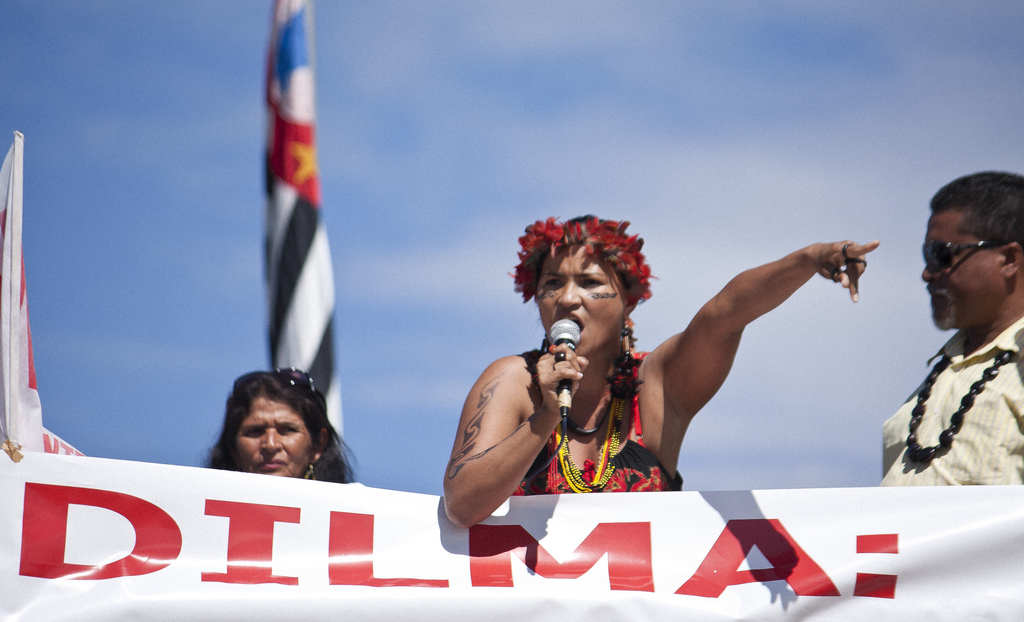
by DGR News Service | Mar 8, 2016 | Protests & Symbolic Acts, Strategy & Analysis
Featured image: Sheyla Juruna/flickr
By Derrick Jensen / Deep Green Resistance
Let me say upfront: I like fun, and I like sex. But I’m sick to death of hearing that we need to make environmentalism fun and sexy. The notion is wrongheaded, disrespectful to the human and nonhuman victims of this culture, an enormous distraction that wastes time and energy we don’t have and undermines whatever slight chance we do have of developing the effective resistance required to stop this culture from killing the planet. The fact that so many people routinely call for environmentalism to be more fun and more sexy reveals not only the weakness of our movement but also the utter lack of seriousness with which even many activists approach the problems we face. When it comes to stopping the murder of the planet, too many environmentalists act more like they’re planning a party than building a movement.
For instance, there’s a video on YouTube of supermodels stripping, allegedly to warn us about global warming. How better to warn us than for a supermodel to shimmy out of her clothes to the accompaniment of a driving rock beat? The tagline beneath the video says, “No matter what your politics are, I think we can all get behind the notion of supermodels stripping.”
Well, not me. The video reinforces the values of a deeply misogynistic culture, where women’s bodies are routinely displayed for consumption by men, where pornography is a 90 billion dollar industry and the single largest commercial use of the internet. And in a movement that already loses women in droves because they’re objectified, harassed, raped, and silenced by men they’d considered comrades, do we really want to use recruiting tools that further this objectification?
Contrast the supermodel strippers with the Message from Sheyla Juruna, also on YouTube. A spokesperson for the indigenous Juruna peoples of the Xingu River in Brazil, Sheyla Juruna stares straight into the camera and says: “The Belo Monte dam is a project of death and destruction. It will decimate our populations and all of our biodiversity . . . We’ve already attempted various forms of dialogue with the government, doing everything we can to block this project, but we have not been heard. I think that it is now time for us to go to war against Belo Monte. No more dialogue. Now is the time to make more resolute and serious acts of resistance against this project.”
I guarantee that Sheyla Juruna did not become an activist for the fun and sex.
What’s more, the “fun and sexy” approach to environmentalism attempts to mobilize techniques that were developed for selling products toward building a movement. Showing a woman’s orgasmic face as she picks up a bottle of fabric softener may influence some people to purchase that brand. But becoming an activist is an entirely different process from buying fabric softener. The former requires fortitude, discipline, and dedication, while the latter requires four dollars to purchase the “natural brand that makes your laundry fluffy, cuddly, and static-free.”
In the arena of public relations, the U.S. military understands all too well something that environmentalists completely fail to grasp: How many recruiting ads have you seen selling the military as fun and sexy? None. An adventure, yes. Service to the community, yes. The few, the proud, yes. All of which, by the way, could and should be said about activism. Recruitment based on fun and sex will attract those who are in it for the fun and sex. Which means that either there will be a very high rate of attrition among such recruits or, far worse, the activism itself will become superficial enough to retain them. It ought to be obvious but in case it’s not: You can’t build a serious movement on superficiality.
The problems themselves are neither fun nor sexy, and the work of resolving these problems is anything but superficial. Organizing is hard work, sometimes tedious, often enraging, and, at this point in the ongoing murder of the planet, nearly always heartbreaking. Sheyla Juruna’s message isn’t about fun and games. Her message is about life and death — her own, that of her people, and that of the land without whom her people are no longer themselves.
Unfortunately, the notion that activism (they never dare call it resistance) has to be fun and sexy pervades the entire environmental movement, from the most self-styled radical to the most mainstream reformist. I have in my hands the most recent issue of the Earth First! Journal, which includes a photo from the most recent Earth First! Rendezvous (events that have a well-deserved reputation for drunken debauchery) depicting young men and women making a naked human pyramid. Remind me what this has to do with stopping this culture from killing the planet? Can you imagine Freedom Riders making coed naked human pyramids, painting their faces, or bringing papier-mâché puppets to sit-ins?
Or consider a recent campaign involving college students stripping to their underwear (do you see a theme?) and running around their campuses. A promotional article titled “Expose Coal Company Lies — With Your Underwear” begins, “Who doesn’t love a good cause that you can support by taking off your pants?” The “project” is a partnership between the Sierra Club and a “stylish underwear brand” called PACT. The Sierra Club, we are told, reports: “Over the past few weeks, students from coal-powered campuses have already used the underwear line in conjunction with organized events such as flash mobs, where students spontaneously [sic] strip down to their ‘Beyond Coal’ underwear, and a race to renewables, a cross-campus underwear run to advocate for the use of cleaner fuel sources.” An embedded video of the “underwear flash mob” is so thoroughly embarrassing (and depressing) that I truly hope you don’t look it up. Beneath the video, the text reads, “Hats Pants off to the Sierra Club and PACT!”
Do I really need to explore what’s wrong with (and creepy about) Sierra Club leaders and underwear makers encouraging young people to take off their clothes, much less pretending this is activism? I’m thinking about a recent global warming campaign where “3,000 people in New Delhi formed an enormous elephant threatened by rising seas — a plea to world leaders not to ignore the ‘elephant in the room.’” I’m thinking about face painting, and I’m thinking about puppets. And I’m thinking how spectacle supplants reality.
I’m also thinking about a conversation I had with some First Nations people in Vancouver, British Columbia, who described how, during the anti-Olympics protests, some Indian warriors were standing firm, alongside some of their nonindigenous allies, facing down police over the desecration of their lands. And they looked behind them and saw a physical separation between themselves on the one hand, and a big cohort of mostly white protesters on the other. But the separation was far more than physical, because the people in front were all dead serious, and behind them were any number of people wearing bunny costumes or running around in cardboard models of bobsleds.
When and why and how did partying and spectacle and debauchery become a substitute for serious political organizing and resistance? How did taking off one’s pants and running around become a political act? And where does dignity fit into any of this? There is, of course, a role for absurdity in political discourse. But the role of absurdity in political discourse is to ridicule and humiliate those in power, not ourselves.
The Jews in the Warsaw Ghetto Uprising took up arms in defense of their lives. The Shawnee war chief Tecumseh took up arms in defense of his people and his land. Harriet Tubman risked her own life to free her people. We, on the other hand, have a long way to go to form a serious resistance movement.
Originally published in the January/February 2012 issue of Orion.
First published online here.
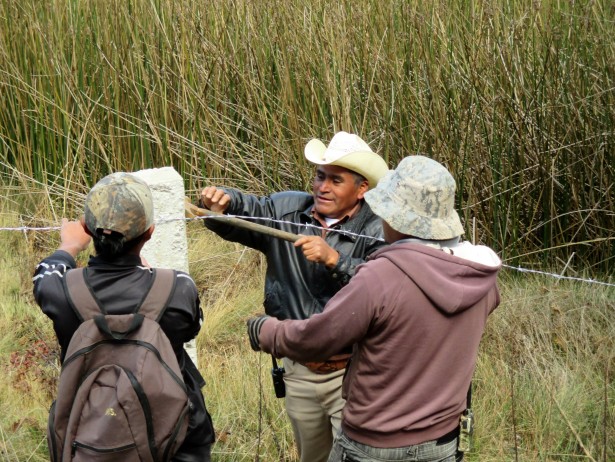
by Deep Green Resistance News Service | Feb 28, 2016 | Biodiversity & Habitat Destruction, Indirect Action
Featured image: Candelaria residents erect a fence around the Suyul Lagoon to help protect it from intruders. (Waging Nonviolence/Sandra Cuffe)
By Sandra Cuffe / Waging Nonviolence
The reeds and grasses are as tall as Sebastián Pérez Méndez, if not taller. The vegetation is so thick it’s hard to see the water in the Suyul Lagoon that he and other local Maya Tzotzil residents are working hard to protect. Pérez Méndez crosses the road to point out where aquatic plants serve as a natural filter for the water as it flows out the lagoon, located in the highlands of Chiapas, in southern Mexico.
“The water is under threat,” he said. Pérez Méndez is the top authority of the Candelaria ejido, a tract of communally-held land in the municipality of San Cristóbal de las Casas. “We’re not going to allow it.”
Communities in Chiapas are organizing to protect the Suyul Lagoon and communal lands from a planned multi-lane highway between the city of San Cristóbal de las Casas and Palenque, where Mayan ruins are a popular tourist destination. Candelaria residents continue to take action locally to protect the lagoon. They also traveled from community to community along the proposed highway route, forming a united movement opposing the project.
It all started back in 2014 when government officials showed up in Candelaria looking for ejido authorities, including Pérez Méndez’ predecessor. It was the first residents had heard about plans for the highway. The indigenous inhabitants had not been consulted and were not shown detailed plans.
“They realized that [the government officials] were only seeking signatures,” Pérez Méndez said.
No one person or group is authorized to make a decision that would affect ejido lands, however, and there are strict conditions in place to ensure elected ejido leaders are accountable to members, he explained. An extraordinary assembly was held to discuss the highway project.
The Candelaria ejido was established in 1935, a year after a new agrarian law enacted during the Lázaro Cárdenas administration led to widespread land reform throughout Mexico. More than 2,000 people live in the 1,600-hectare ejido, and more than 800 of them are ejidatarios — legally recognized communal land holders whose rights have been passed down for generations. Only ejidatarios as a whole have the power to make decisions on issues like the highway project.
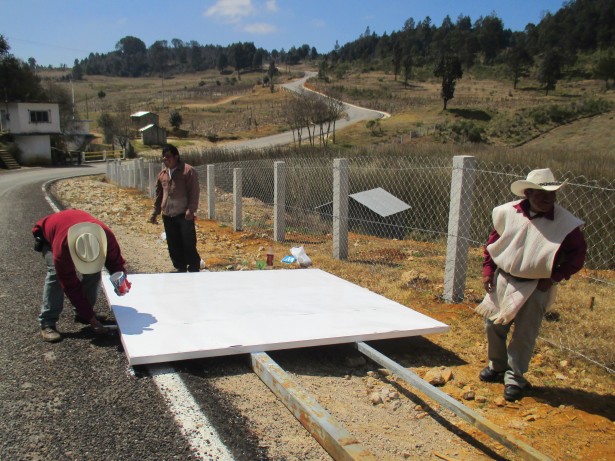
Candelaria residents paint over graffiti to fix up a roadside sign proclaiming their opposition to the highway project. (Waging Nonviolence/Sandra Cuffe)
“The ejido said no,” said Guadalupe Moshan, who works for the Fray Bartolomé de Las Casas Human Rights Center, or FrayBa, supporting Candelaria and other communities in Chiapas. “They didn’t sign.”
Candelaria leaders sought assistance from FrayBa in 2014, after they were approached by government officials and pressured to sign a document indicating their consent to the highway project that would involve a 60-meter-wide easement through communally-held lands. Officials told community members that the highway was already approved and that they would be well compensated, but that there would consequences if they refused to sign, Moshan said.
“They told them they would suspend government programs and services,” she explained. In the days following the extraordinary ejido assembly rejecting the project, there was unusual activity in the area, according to Moshan. Helicopters flew over theejido, unknown individuals entered at night, and trees were marked, she said.
Protecting the Suyul Lagoon remains at the heart of Candelaria’s opposition to the planned highway. The lagoon provides potable water not only for Candelaria, but also for several nearby communities, said ejido council secretary Juan Octavio Gómez. Aside from the highway itself, project plans eventually shown to the community leaders include a proposed eco-tourism complex right next to the lagoon. That isn’t in the communities’ interest, Gómez explained.
“Water is life. We can’t live without it,” he said. “Without this lagoon, we don’t have another option for water.”
Fed by a natural spring, the Suyul Lagoon never runs dry. Local residents are careful to protect the water and lands in the ejido, where the majority of residents live from subsistence agriculture, sheep rearing and carpentry. They engage in community reforestation, but have plans to plant more trees, Gómez said.
The Suyul Lagoon is also sacred to local Maya Tzotzil. Ceremonies held every three years in its honor involve rituals, offerings, music and dance.
“It is said that it’s the navel of Mother Earth,” Pérez Méndez said.
Candelaria residents didn’t sit back and relax after rejecting the highway project in their extraordinary assembly. They have been organizing ever since. The Suyul Lagoon lies just outside the Candelaria ejido, but it belongs to ejidatarios by way of an agreement with the supportive land owner. Aside from the highway project and potential eco-tourism complex, the lagoon has caught the attention of companies, whose representatives have turned up in the area expressing interest in establishing a bottling plant.
It’s cold in February up in the highlands, but community members have been out all day, erecting a fence around the Suyul Lagoon to protect it from intruders. White fence posts are visible under the treeline across the sea of reeds. Like so many other local initiatives, fence materials are collectively financed by the ejido and the labor is all voluntary, communal work.
While residents continue stringing barbed wire from post to post, others take paintbrushes to one of their roadside signs. Locals have erected large signs next to roads in and around their ejido, announcing their opposition to the tourist highway.
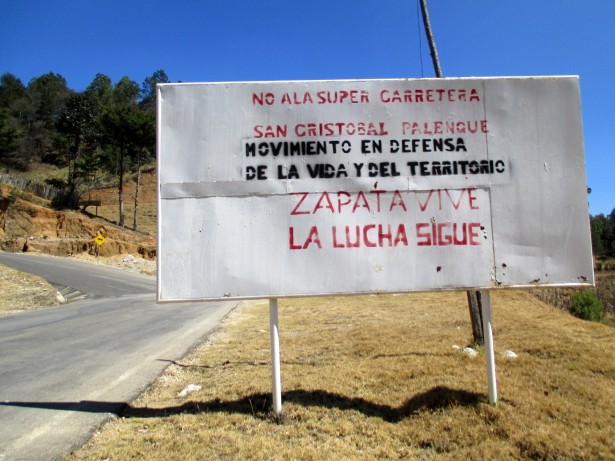
A sign along the road leading to Candelaria informs passers-by of opposition to the planned super-highway. (Waging Nonviolence/Sandra Cuffe)
“We’re also already organized with the other communities,” Pérez Méndez said. “All the communities reject the super-highway.”
After they were approached by government officials, Candelaria ejido residents traveled from community to community along the entire planned highway route. Some communities hadn’t heard of the project at all, while others said they were pressured into signing documents indicating their consent, Pérez Méndez said. As a result of Candelaria’s visits, community organizing along the highway route led to the formation of a united front of opposition, the Movement in Defense of Life and Territory.
Candelaria also recently got together with other indigenous communities in the highlands to issue a joint statement rejecting the tourist super-highway and a host of other government and corporate projects and policies.
“Our ancestors, our grandfathers and our grandmothers have always taken care of these blessed lands, and now it’s our turn to [not only take] care of the lands, but also to defend them,” reads the February 10 communiqué.
“The neoliberal capitalist system, in its ambition to exploit natural assets, invades our lands,” the statement continues. “The government and transnational companies are violently imposing their mega-projects.”
Back along the edge of the Suyul Lagoon, Candelaria residents continue to string barbed wire from post to post. They’ve been at it for a while now, according to Pérez Méndez, but they’ve now stepped up their efforts and hope to finish the fence by the end of the month.
Pérez Méndez surveys the progress, protected from the unrelenting sun and icy wind by his hat and white sheep’s wool tunic. He becomes pensive when asked if he thinks communities will be able to defeat the highway project.
“Yes,” the ejido leader said, after giving it some thought. “We can stop it.”
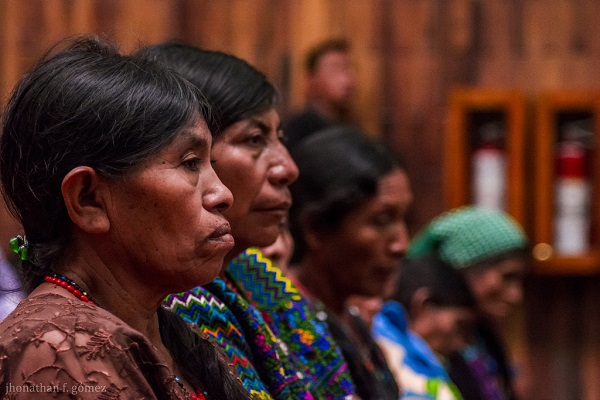
by Deep Green Resistance News Service | Feb 21, 2016 | Lobbying, Rape Culture
By Jhonathan F. Gómez / Upside Down World
All photos from Supreme Court trial by Jhonathan F. Gómez
Maya Q’eqchi’ women survivors recently entered the Supreme Court in Guatemala as part of the Sepur Zarco case to demand justice for sexual violence, sexual and domestic slavery, forced disappearances and murder, crimes committed during the internal armed conflict of 1960-1996. On February 1, 2016, Army Lieutenant Colonel Francisco Esteelmer Reyes Girón and military commissioner Heriberto Valdés Asij appeared before the court as another historic trial began.
The Sepur Zarco case is representative of the current state of justice for women in Guatemala. It serves as a reminder that the work towards bringing those responsible for genocide and crimes against humanity is an extensive and challenging process anywhere in the world.
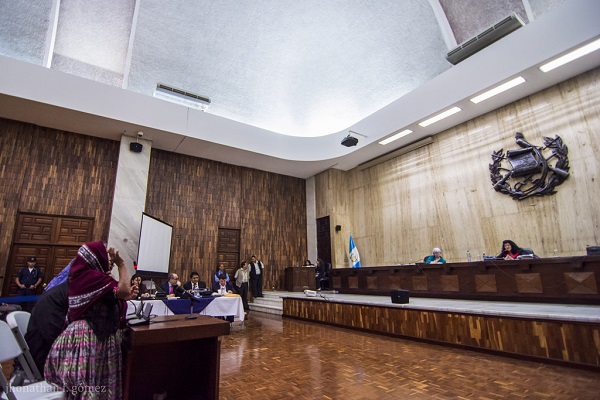
The case goes back to 1982, when the army built a military outpost between the departments of Alta Verapaz and Izabal. Built by forced labor from men of the communities of Panzós and El Estor, it was designated as a resting area for the troops. Late in 1982, the army captured and disappeared Maya Q’eqchi’ men who were fighting for their rights to the land in the area. Consequently, the army took advantage of the widowed women and declared them “alone and available,” forcing them into domestic and sexual slavery. The women were subjected to inhumane conditions, repeatedly raped, gang raped and forced to cook and clean for the army.
These crimes occurred when retired general José Efraín Ríos Mont Ríos Montt was president. Part of his government’s policy was to eliminate the Mayan people by way of displacement, disappearances, murder or forced exile. (Ríos Montt is currently waiting retrial to face justice for his crimes.)

In 1993, the United Nation’s Historical Clarification Commission collected testimonies which allowed for an understanding of what happened. However, a broader understanding of what took place began to surface further in 2000 when the Community Research and Psychosocial Action Team (Equipo de Estudios Comunitarios y Acción Psicosocial, ECAP) conducted psychosocial work with women of the Sepur Zarco region.
The roots of this landmark case are part of a living history which Maya Q’eqchi’ women have been working for years at the community level in the pursuit of justice. In 2009, an independent psychosocial investigation, which led to the publication of a book called Tejidos Que Lleva el Alma (The Weavings that Our Soul Carry) was conducted by ECAP and the National Union of Guatemalan Women (Unión Nacional de Mujeres Guatemaltecas, UNAMG). The book’s aim was to bring the stories of Mayan women survivors into the public consciousness.
In 2010, a symbolic Court of Conscience (Tribunal de Conciencia) against sexual violence for crimes committed during the armed conflict was conducted as a public act by the women survivors. It signaled a breaking of the silence and promoted the sharing of stories with the clear objective that nothing of that nature should ever happen again. The event was organized by various community organizations and with the support of multiple embassies including those from Costa Rica, Spain, Germany Norway and Sweden. Following the symbolic act, the women took a step forward with strategic litigation within the Guatemala justice system.
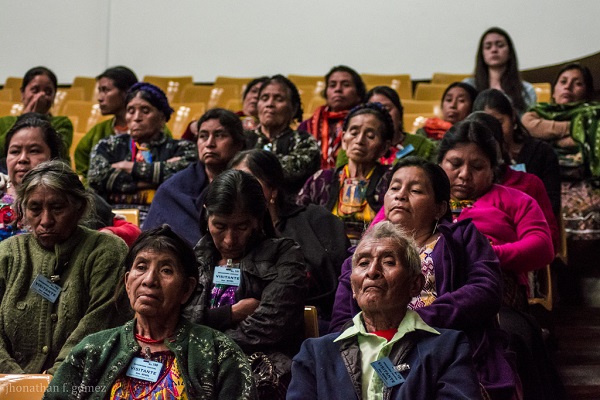
The Breaking the Silence and Impunity Alliance (Alianza Rompiendo el Silencio y la Impunidad), which consists of three grassroots organizations, came together the same year to accompany the legal proceedings of the women survivors. The women survivors have waited over 30 years to see any inclination of justice, and this case can therefore have a large impact in Guatemala and around the world.
The significance of the case cannot be overstated. It is the first time in the world where a national court, in the context of a criminal trial will hear charges against sexual violence during war, as well as the first time a national court will hear charges against sexual and domestic slavery, also in the context of war. The case can set precedents on how sexual violence is judged at a national and international level. Ada I. Valenzuela López from UNAMG states, “In our society, no one else will position sexual violence as an issue in this context. It is a violence which has been silenced for many years. It is almost never at the forefront of any debate in the courts or our society.”
The case stands to move public opinion forward in the struggle for gender justice. It can serve as a step to strengthen trust in a justice system that is capable of hearing the voices of women, and not shaming nor stigmatizing them for speaking out as survivors of sexual violence. It is particularly important for an indigenous population that has been historically discriminated and marginalized to trust in due process. Fifteen women have already testified during the intermediate phase of the case. Many of them have faced threats because of their testimony, yet all of them continue to stand strong because they share a collective understanding of the importance of the trial.
On September 2011, criminal charges were filed in Puerto Barrios, Izabal against military officials Reyes Girón and Valdés Asij. On December, 2011, exhumations were performed at the military outpost. In July of 2012, the prosecutor’s office requested before the Supreme Court that the case be transferred to the High Risk Court. In September of that year, survivors and witnesses presented testimonies before Judge Miguel Ángel Gálvez Aguilar who precedes High Risk Court B.
Arrests were made for Reyes Girón and Valdés Asij in June 14, 2014. On June 23, the first hearing was held and in October, the intermediate phase began which prompted the judge to request a trial date. Immediately after the defense filed a writ of amparo, a legal remedy for the protection of constitutional rights, which was rejected by the Constitutional Court in April of 2015.
In March, April and May of 2015, hearings were suspended because the defense attorneys were not present and because of health problems by Francisco Esteelmer Reyes Girón. Esteelmer Girón had been hospitalized and the defense stated that he was in “poor health.” On June 23, the judge restarted the public debate and the case was sent to the High Risk Court A, comprised by judges Yassmín Barrios, Patricia Bustamante and Gerbi Sical.
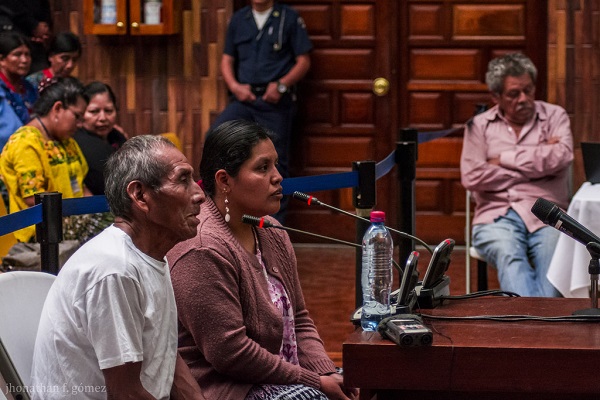
On February 1 of this year, the trial began. It faces many challenges, both in the domain of public opinion, as well as in the trial itself. The defense continues to defame survivors’ organizations, witnesses and uses legal methods to delay the trial. Many organizations have denounced the defense’s methods as a way to evade justice and promote a culture of impunity. Jo-Marie Burt from the Washington Office on Latin America reiterates that “the challenge here is to prove that these types of crimes can be investigated, brought to trial and judged. And to seek to generate mechanism or protocols for the army understand that violence against women cannot be used as an instrument of war, and that women are not war trophies.”
On February 9, the plaintiffs presented over 30 boxes as evidence which contained the remains found in various exhumations which the Forensic Anthropology Foundation of Guatemala (Fundacion de Antropologia Forense de Guatemala, FAFG) conducted. As the contents of the boxes were presented, many people who attended the trial as observers and supporters walked out of the courtroom because of their graphic nature. Evidence of this nature has not always been used at such trials, making it an even more important method of illustrating the magnitude of the crimes.
As a show of support for the Maya Q’eqchi’ women who will be testifying, women from various regions across the country have been present through the trial. As the country watches another historic trial unfold, the survivors are clear on their position. They seek justice and will not rest in peace until justice is served. They want to bring the issue of sexual violence into the public conversation and to show that it is hard for women to speak out against this type of violence. They want their voices to be heard, their truth to be known. They want society to understand that what happened to them was not their fault, and most importantly, that no other woman in Guatemala, or anywhere in the world, experiences what they lived through.
Jhonathan F. Gómez, is a documentary photographer currently living in Guatemala City. He is commitment to documenting the subaltern and diasporic realities of Guatemala as they relate to historic memory, race, class, gender, sexuality, identity and justice.
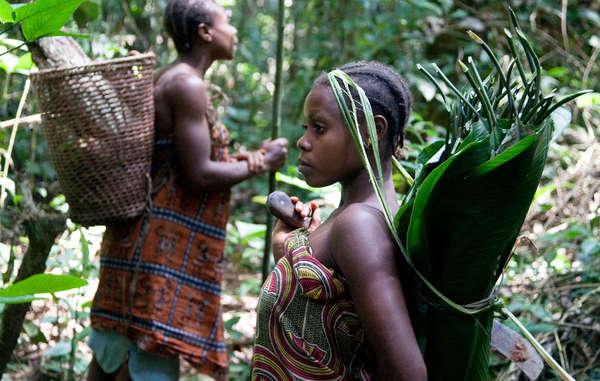
by Deep Green Resistance News Service | Feb 16, 2016 | Lobbying
Featured image: The Baka have lived sustainably in the central African rainforest for generations as hunter-gatherers
© Selcen Kucukustel/Atlas
By Survival International
Survival International has launched a formal complaint about the activities of the World Wide Fund for Nature (WWF) in Cameroon.
This is the first time a conservation organization has been the subject of a complaint to the OECD (Organization for Economic Cooperation and Development), using a procedure more normally invoked against multinational corporations. Survival International has launched a formal complaint about the activities of the World Wide Fund for Nature (WWF) in Cameroon.
The complaint charges WWF with involvement in violent abuse and land theft against Baka “Pygmies” in Cameroon, carried out by anti-poaching squads which it in part funds and equips.
Before beginning its work in Cameroon, WWF failed to consider what impact it would have on the Baka. As a result, WWF has contributed to serious human rights violations and broken the United Nations Declaration on the Rights of Indigenous Peoples. It supports conservation zones on Baka land, to which the Baka are denied access, as well as the anti-poaching squads that have violently abused Baka men and women, and other rainforest tribes, for well over a decade.
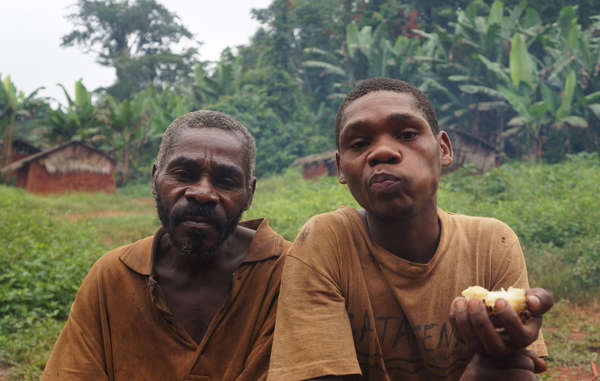
Forced out of the forest, many Baka communities complain of a serious decline in their health. Living on the roadside, they are increasingly exposed to malaria and other diseases.
© Survival International
The international conservation organization has thereby violated both OECD human rights guidelines and its own policy on indigenous peoples, and Survival’s legal team has therefore submitted a formal complaint.
Baka have repeatedly testified to Survival about the activities of these anti-poaching squads in the region. In 2015 one Baka man said: “When they came to beat me here in my home, my wife and I were sleeping. They beat me with machetes. They beat my wife with machetes.”
Survival International is calling for a new approach to conservation that respects tribal peoples’ rights. Tribal peoples have been dependent on and managed their environments for millennia. Despite this, big conservation organizations are partnering with industry and tourism and destroying the best conservationists and guardians of the natural world – tribes. They are the environment’s best allies, and should be at the centre of conservation policy.“They are letting the elephants die out in the forest at the same time as they are stopping us from eating,” another Baka man told Survival. Today, the destruction of Baka land through logging, mining and the trafficking of wildlife continues, provoking concern among tribespeople that their land is being destroyed, even as they are denied access to large parts of it in the name of conservation.
Survival’s Director Stephen Corry said today: “WWF knows that the men its supporters fund for conservation work repeatedly abuse, and even torture, the Baka, whose land has been stolen for conservation zones. It hasn’t stopped them, and it treats criticism as something to be countered with yet more public relations. It calls on companies to stick to the same OECD guidelines it routinely violates itself. Both conservation and development have been allowed to trump human rights for decades and millions of people in Africa and Asia have suffered as a result. It’s time the big conservation organizations got their act together. If WWF really can’t stop the guards it funds in Cameroon from attacking Baka, then perhaps it should be asking itself if it has any right to be there at all.”
Survival International is the global movement for tribal peoples’ rights. We help tribal people defend their lives, protect their lands and determine their own futures. Founded in 1969.
by Deep Green Resistance News Service | Jan 26, 2016 | Lobbying
Native advocates for the creation of Bears Ears National Monument in southeastern Utah will begin meetings later this month with the administration of President Barack Obama after parting company with Congressional delegates who they say repeatedly disrespected their efforts.
The proposed 1.9-million-acre monument lies north of the Navajo Nation and the San Juan River, east of the Colorado River, and west of the Ute Mountain Ute Reservation. It encompasses all of Natural Bridges National Monument and the Manti La Sal National Forest, and parts of Glen Canyon National Recreation Area. It is adjacent to, and immediately east of, Canyonlands National Park.
RELATED:Tribes Ask President Obama to Designate Bears Ears as National Monument
The drumbeat to protect the landscape began six years ago with local Navajo and non-Native activists and quickly garnered the support of local rock climbing groups who liked the idea of protecting some of their favorite recreation areas.
RELATED: Bears Ears Sacred Site Unites 24 Tribes With Rock Climbers, Conservationists
The past year saw the formation of the Bears Ears Coalition, with representatives from the Navajo, Hopi, Ute Mountain Ute, Uinta & Ouray Ute and Zuni nations, which furthered those initial efforts to draw wide support from southwestern pueblos and tribes as well as the National Congress of American Indians.
“This is about healing. We’re not only trying to heal the land and its ecology, but people who relate to these lands,” said Eric Descheenie, advisor to Navajo Nation President Russell Begaye, and co-chair of the Bears Ears Coalition. “This is an indigenous vision that has inspired cross-disciplinary professionals to join on. We have non-Indians, we have all kinds of groups in the public and private sector. We want to elevate this discussion in a way that we can all celebrate.”
Members of the Coalition unveiled a formal monument proposal in Washington last fall that advances an unprecedented vision for collaborative management between tribes and the federal government.
RELATED: Bears Ears 1.9 Million–Acre Monument Would Be Unique Tribal-Federal Collaboration
Even in October, Coalition members viewed their proposal as a more protective alternative to the Public Lands Initiative (PLI) spearheaded by representatives Rob Bishop (R-Utah) and Jason Chaffetz (R-Utah). In an appendix, they chronicled six years of tribal members’ thwarted attempts to work within the PLI process in both Utah and Washington D.C.—efforts that were met with polite indifference at best, and racism at worst. Still, the coalition made one more effort to work within the PLI.
“I was excited with the thought that we might be able to work within the legislative process,” recalls Regina Lopez-Whiteskunk, a member of both the Bears Ears Coalition and the Ute Mountain Ute Tribal Council. But she said she was disappointed with the one-sided nature of the efforts.
“I had to take a step back and really think about how the federal government interacts with tribes,” she said. “When we pursue grants for the development of programs, we’re given deadlines and requirements, and we take them very seriously.” But Lopez-Whiteskunk said the PLI leaders consistently blew deadlines, never produced promised drafts of their own proposal, and failed to show up for scheduled meetings.
“When I started to see things kind of falling by the wayside, I began to realize, maybe the only way we’re going to be able to do this is through the executive order process,” she said.
Lopez-Whiteskunk said she owes it to her people, and her ancestors who once inhabited the Bears Ears lands, to forego the legislative path. Instead, the Coalition is pursuing negotiations with the Obama administration to secure a presidential proclamation under the Antiquities Act.
“We have come to the conclusion that we have no choice but to discontinue these discussions,” reads part of the Coalition’s letter to Chaffetz and Bishop, dated December 31. “Our strenuous efforts to participate in the PLI have been consistently stonewalled. We have never been taken seriously.”
Chaffetz issued a statement in response to the letter, calling it “unexpected and confusing.” He chalked up his staff’s failure to show up at a scheduled December 30 meeting with the Coalition as a “scheduling conflict” and vowed to move forward with the PLI.
Bishop also responded, saying the coalition did not represent all interests.
“The Native Americans who live in Utah and who would be most impacted by a national monument do NOT support the proposal of this group,” he wrote in a statement e-mailed by his communications director, Lee Lonsberry. “It is clear this self-appointed coalition has an agenda that we need to reconcile with the wishes of those who actually call Utah home.”
Lonsberry added that the Navajo Nation’s Aneth Chapter, which lies closest to the proposed monument and within Utah, is against the proposal. But the Navajo Nation Council passed a resolution in support of the Bears Ears proposal last fall, with unanimous support by delegates representing the Nation’s 110 chapters. Council Delegate Davis Filfred, who represents five chapters in Utah including Aneth, says the statements are unfounded and misleading. He pointed out that six of seven Utah chapters support the Bears Ears proposal.
“The Navajo Nation is supporting Bears Ears,” he said, “not only from the council, but from the executive side as well. I do support this.”
For his part, Descheenie took offense at Bishop’s characterization of the Bears Ears Coalition as what he called a “self-appointed coalition.”
“We don’t feel they respect the sovereignty of tribes,” he said.
Descheenie added that he’s proud of the coalition’s proposal and looks forward to earnest negotiations with the Obama administration.
“My hope is that when we take our ideas and match them up against the Obama administration’s expertise, our proposal will become that much better, and that it truly will become a model for collaborative management worldwide,” he said. “We’re hoping that people come to the table with positive hearts and fruitful minds, with an interest in figuring out how this can work.”
Lopez-Whiteskunk said she’s excited for an opportunity to showcase a great idea out of Indian country.
“I’ve been elected by my people, but now I have an opportunity to be a leader for many people,” she said. “This is about healing that doesn’t see colors or boundaries. It’s not just going to be a people’s movement of the Native people. It will be a peoples’ movement for all people.”
Anne Minard is a journalist and a law student at the University of New Mexico. She is working for the Bears Ears Coalition as a legal research assistant.












